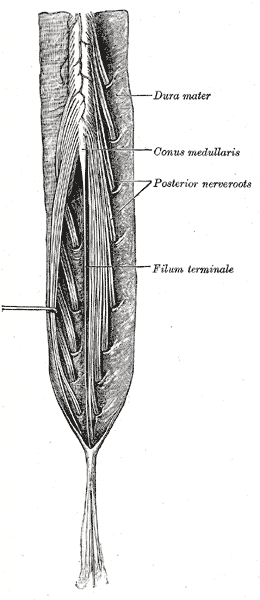Cauda equina syndrome: Difference between revisions
Jump to navigation
Jump to search
No edit summary |
No edit summary |
||
| Line 14: | Line 14: | ||
MeshNumber = C10.668.829.800.750.700 | | MeshNumber = C10.668.829.800.750.700 | | ||
}} | }} | ||
{{CMG}} {{JE}} | {{CMG}} '''Associate Editor(s)-in-Chief:''' {{JE}} | ||
{{SI}} | {{SI}} | ||
==Overview== | ==Overview== | ||
==Historical perspective== | |||
==Classification== | |||
==Pathophysiology== | |||
==Causes== | ==Causes== | ||
== | ==Differentiating cauda equina syndrome from other Diseases== | ||
==Epidemiology and Demographics== | |||
==Risk Factors== | |||
==Screening== | |||
==Natural History, Complications, and Prognosis== | |||
==Diagnosis== | ==Diagnosis== | ||
'''Diagnostic Study of Choice''' | |||
'''History and Symptoms''' | |||
'''Physical Examination''' | |||
'''Laboratory findinds''' | |||
'''X-ray''' | |||
'''Ultrasound''' | |||
'''CT Scan''' | |||
'''MRI''' | |||
'''Other Imaging Findings''' | |||
'''Other Imaging Findings''' | |||
==Treatment== | ==Treatment== | ||
'''Medical Treatment''' | |||
'''Surgery''' | |||
'''Primary Prevention''' | |||
'''Secondary Prevention''' | |||
==References== | ==References== | ||
Revision as of 18:27, 12 July 2020
| Cauda equina syndrome | ||
 | ||
|---|---|---|
| Cauda equina and filum terminale seen from behind. | ||
| ICD-10 | G83.4 | |
| ICD-9 | 344.6 | |
| DiseasesDB | 31115 | |
| MeSH | C10.668.829.800.750.700 | |
Editor-In-Chief: C. Michael Gibson, M.S., M.D. [1] Associate Editor(s)-in-Chief: Joanna Ekabua, M.D. [2]
Overview
Historical perspective
Classification
Pathophysiology
Causes
Differentiating cauda equina syndrome from other Diseases
Epidemiology and Demographics
Risk Factors
Screening
Natural History, Complications, and Prognosis
Diagnosis
Diagnostic Study of Choice
History and Symptoms
Physical Examination
Laboratory findinds
X-ray
Ultrasound
CT Scan
MRI
Other Imaging Findings
Other Imaging Findings
Treatment
Medical Treatment
Surgery
Primary Prevention
Secondary Prevention
References
Template:Neuroscience-stub Template:Cerebral palsy and other paralytic syndromes [{Category:Needs patient information]] de:Cauda-equina-Syndrom